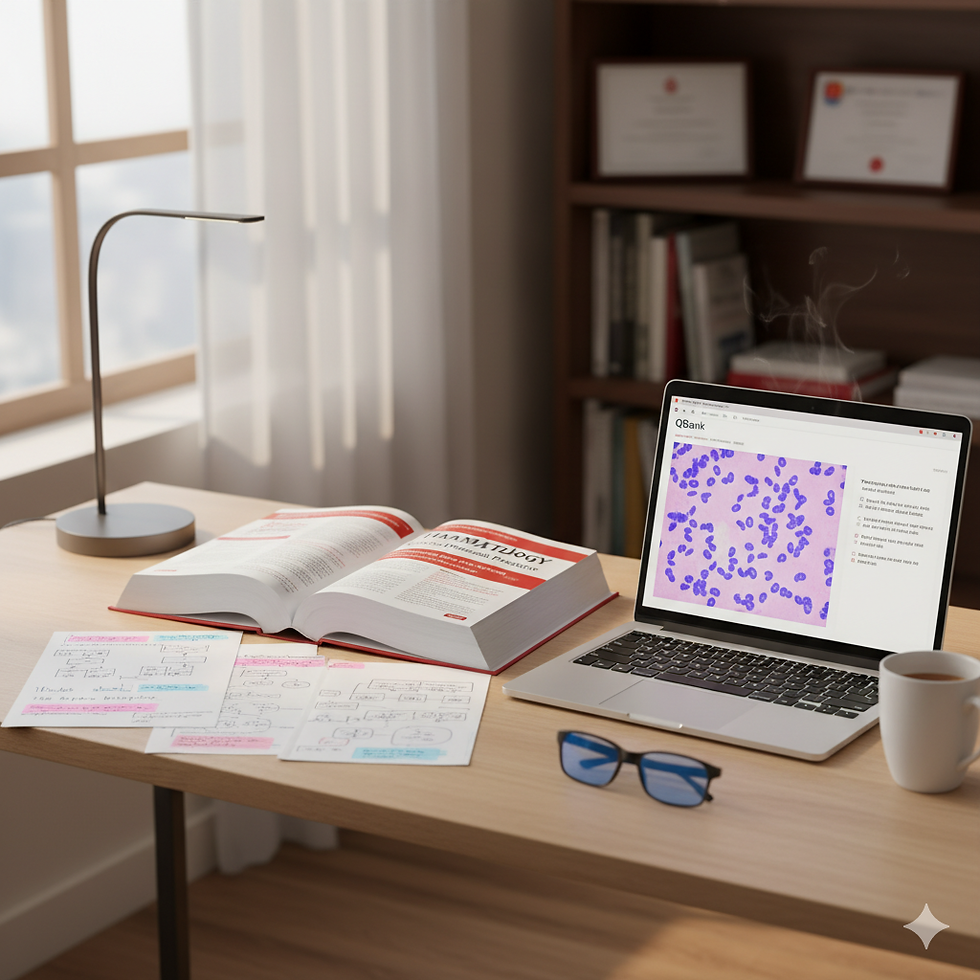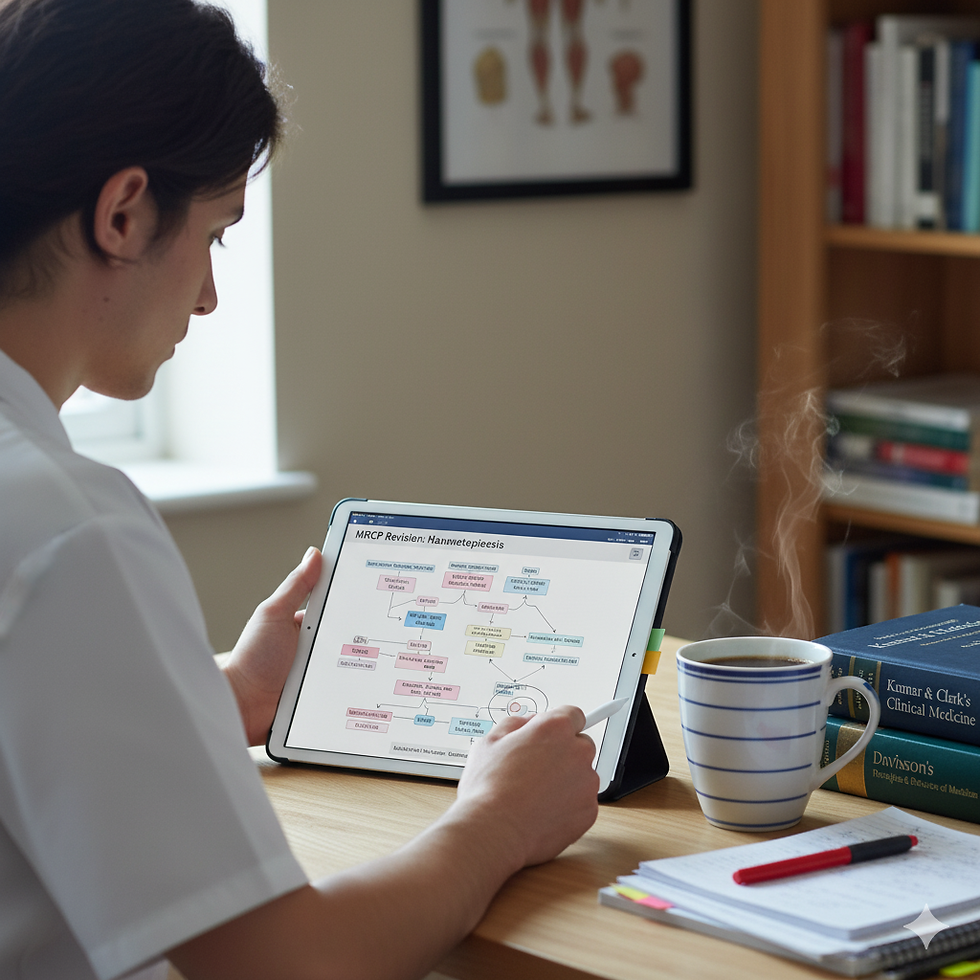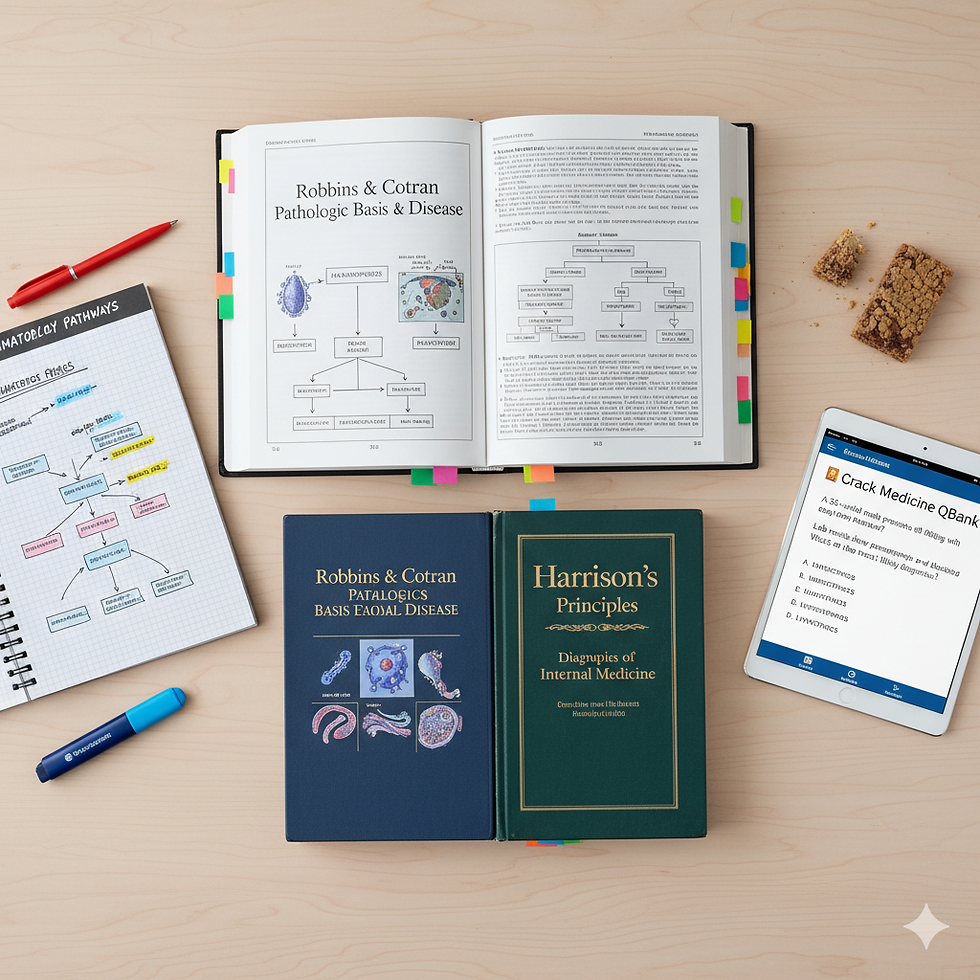Image-Based Questions in Hematology (MRCP Part 1)
- Crack Medicine

- 22 hours ago
- 4 min read
TL;DR
Image-based questions in Hematology for MRCP Part 1 often feature blood films, bone marrow smears, or histology slides testing diagnostic pattern recognition. Learn to identify key morphologies—like spherocytes, blasts, or schistocytes—and link them with their clinical context. This article covers high-yield image features, examples, pitfalls, and efficient study tactics.
Why image-based Hematology matters
Image-based questions in MRCP Part 1 assess not only factual recall but visual pattern recognition — the ability to interpret what you see on a slide and connect it with the right diagnosis. These questions typically account for 5–10% of the Hematology section, based on exam feedback from the Royal College of Physicians’ MRCP(UK) format.
Recognising a sickled cell or a hypersegmented neutrophil within seconds can secure vital marks. Crack Medicine’s Free MRCP MCQs and detailed image sets replicate this style closely to strengthen your visual memory.
Typical image question formats
You might encounter any of the following image types:
Peripheral blood films – RBC and WBC morphologies, inclusion bodies.
Bone marrow aspirates/biopsies – identifying blasts, fibrosis, or megaloblasts.
Special stains – e.g., Prussian blue for iron, Giemsa for parasites, MPO for myeloid lineage.
Automated outputs – histograms, reticulocyte graphs, or flow cytometry scatter plots.
Histopathology snippets – particularly for leukaemias or lymphomas.
Each question integrates the image + clinical vignette + lab parameters, demanding both interpretation and reasoning.
High-Yield Image Morphologies
Morphological Feature | Classical Association | Interpretation Tip |
Sickle cells | Sickle cell anaemia | Elongated, curved RBCs; think vaso-occlusive crisis. |
Target cells | Thalassaemia, liver disease | Central pallor with peripheral ring — microcytosis clue. |
Spherocytes | Autoimmune haemolytic anaemia, hereditary spherocytosis | Round, no central pallor; confirm with reticulocytosis. |
Schistocytes | DIC, TTP, HUS | RBC fragments — correlate with thrombocytopenia. |
Blasts with Auer rods | Acute myeloid leukaemia | Needle-like inclusions — urgent haematology referral. |
Hypersegmented neutrophils | Megaloblastic anaemia | >5 nuclear lobes; classic of B12 or folate deficiency. |
Teardrop cells (dacrocytes) | Myelofibrosis | Deformed cells from fibrotic marrow. |
Howell–Jolly bodies | Post-splenectomy, megaloblastic anaemia | Nuclear remnants in RBCs; suggest hyposplenism. |
Source: British Society for Haematology Education Portal.
The five most examined subtopics
Anaemias: Distinguish microcytic, macrocytic, and normocytic patterns visually.
Haemolytic disorders: Recognise spherocytes, bite cells, or Heinz bodies.
Leukaemias: Differentiate myeloblasts (Auer rods) vs lymphoblasts.
Bone marrow failure: Hypocellularity vs hypercellularity cues.
Thrombocytopenic syndromes: Identify platelet clumps and schistocytes in TTP or DIC.
Knowing these visual archetypes can help you answer even when uncertain of terminology.
Mini-Case Example
Question: A 24-year-old man presents with jaundice and dark urine two weeks after starting high-dose amoxicillin. Peripheral smear shows spherocytes and polychromasia. Direct antiglobulin test (DAT) positive.
Most likely diagnosis: A. G6PD deficiencyB. Autoimmune haemolytic anaemiaC. Hereditary spherocytosisD. Aplastic anaemia
Answer: B. Autoimmune haemolytic anaemia Explanation: Drug-induced immune haemolysis shows spherocytes with a positive DAT. G6PD deficiency produces bite cells, not spherocytes.

Practical study tips
Revise morphology daily: Review 5–10 slides/day from credible sources like Atlas of Haematology (ASH Image Bank).
Integrate visual with labs: Always check MCV, reticulocytes, and WBC count alongside images.
Simulate real timing: Practise under 90-second question limits using mock tests.
Create visual flashcards: Screenshot tricky images and label features to improve retention.
Cross-link to concepts: Reinforce with Crack Medicine’s lectures on haematology differentials available at /lectures/.
Common pitfalls and how to avoid them
Confusing artefacts for pathology: Dust or platelets may mimic inclusions — rely on pattern repetition.
Over-focusing on a single cell: Assess overall morphology, not one outlier.
Ignoring context: Always read patient age, presentation, and blood indices.
Mixing up leukaemia types: Remember—Auer rods → myeloid; coarse chromatin → lymphoid.
Neglecting rare but testable cells: Basophilic stippling and teardrop cells often appear in “easy-to-miss” questions.
How Crack Medicine helps
Crack Medicine’s QBank includes high-resolution blood film questions and annotated image explanations. The mock tests simulate exam conditions, with new image sets every month. The integrated app analytics highlight your weak morphologies, helping you focus your final-week revision efficiently.
Note: The Crack Medicine app releases monthly new mock tests and detailed performance analytics so you can track progress visually and numerically — a unique advantage over static question banks.
FAQs
1. How many image-based questions appear in MRCP Part 1?
Typically 5–10% in the Hematology domain, though this varies each exam cycle according to MRCP(UK) blueprints.
2. What is the best way to learn morphology?
Repeated visual exposure and self-testing — Crack Medicine’s annotated images mirror the official exam layout.
3. Do I need to memorise every red cell shape?
No. Focus on hallmark ones: sickle, target, spherocyte, schistocyte, and teardrop.
4. Are bone marrow images tested?
Yes, occasionally — particularly for leukaemia and aplastic anaemia recognition.
5. Is it worth practising from external atlases?
Absolutely. The ASH Image Bank and British Society for Haematology are reliable, evidence-based sources.
Ready to start?
Mastering image-based questions in Hematology (MRCP Part 1) is about pattern familiarity, not memorisation. Build a habit of daily slide review, correlate morphology with lab values, and test yourself under exam pressure. Explore Crack Medicine’s MRCP Part 1 overview for structured guidance, or jump into our Free MRCP MCQs to start building visual mastery today.
Sources
MRCP(UK) Part 1 Exam Format
British Society for Haematology Education Resources



Comments